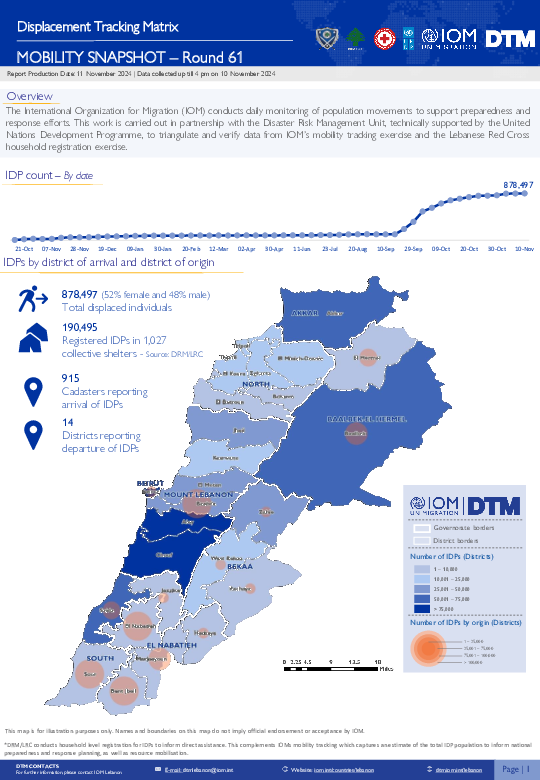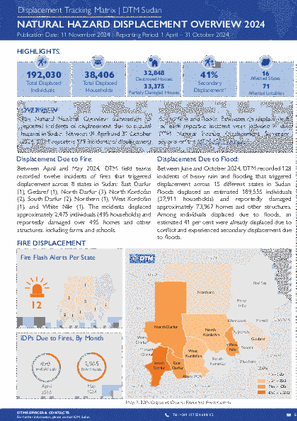-
Countries
-
Data and Analysis
-
Special Focus
-
Crisis Responses

Contact
DTM Somalia, IOMSomaliaDTM@iom.int
Language
English
Location
Somalia
Period Covered
Nov 02 2024
Nov 06 2024
Activity
- Mobility Tracking
- Baseline Assessment
This latest round of Emergency Trends Tracking was initiated in April 2024 to monitor displacements movements during the Gu rainy season. From April to September 2024, DTM teams collected data in up to 22 districts: Afgooye, Afmadow, Baardheere, Baidoa, Balcad, Belet Weyne, Belet Xaawo, Cabudwaaq, Dayniile, Dhuusamarreeb, Doolow, Gaalkacyo, Garoowe, Hodan, Jamaame, Jowhar, Kahda, Kismaayo, Luuq, Waajid, Xudur and Hobyo. As of Round 28, data collection occurred in only 4 districts: Xudur, Waajid, Gaalkacyo and Hobyo districts.
The objective of ETT is to help prioritize humanitarian response and to enable partners to deliver rapid assistance. Based on previous shock induced displacement patterns, the humanitarian community expects that people will continue to move toward urban areas in search of humanitarian services. Consequently, the ETT coverage focuses on the main urban centers and surrounding villages for each assessed district. The data is collected through Key Informant Interviews (KIIs) at the location level, from Sunday to Wednesday every week. It includes information on new arrivals, numbers and demographic of IDPs, reasons for displacement, intentions, humanitarian assistance and priority needs among others.
To facilitate the joint analysis of the CCCM (Camp Coordination and Camp Management) Cluster’s New Arrivals Tracker (NAT) and ETT data, the assistance and needs indicators are identical in both tools.
Contact
DTMUkraine@iom.int
Location
Ukraine
Activity
- Mobility Tracking
- Baseline Assessment
Period Covered
Jul 01 2024 -Aug 31 2024
- Kharkivska (388,410), Dnipropetrovska (377,713), and Kyivska (256,397) Oblasts have the highest numbers of officially registered IDPs.
- Across the country, around 5 per cent of registered IDPs have a state-recognised disability status.
- Sixty per cent of registered IDPs were female, whereas 40 per cent were male. Twenty–nine per cent of registered IDPs were under 18, 48 per cent – between 18 and 59, and 23 per cent were aged 60 and over.
A more detailed version of this dataset at the Hromada level is available. To get access, kindly click on the 'Request Access' button.
Population Groups
IDPs
Survey Methodology
Unit of Analysis Or Observation
Admin Area 2
Admin Area 3
Type of Survey or Assessment
Key Informant
Keywords
Geographical Scope Partial Coverage
Administrative boundaries with available data
The current dataset covers the following administrative boundaries
Contact
DTMUkraine@iom.int
Location
Ukraine
Activity
- Mobility Tracking
- Baseline Assessment
Period Covered
Sep 01 2024 -Oct 31 2024
- Kharkivska (390,872), Dnipropetrovska (379,133), and Kyivska (257,606) Oblasts have the highest numbers of officially registered IDPs.
- Across the country, around 10 per cent of registered IDPs have a state-recognised disability status.
- Sixty per cent of registered IDPs were female, whereas 40 per cent were male. Twenty–five per cent of registered IDPs were under 18, 52 per cent – between 18 and 59, and 23 per cent were aged 60 and over.
A more detailed version of this dataset at the Hromada level is available. To get access, kindly click on the 'Request Access' button.
Population Groups
IDPs
Survey Methodology
Unit of Analysis Or Observation
Admin Area 2
Admin Area 3
Type of Survey or Assessment
Key Informant
Keywords
Geographical Scope Partial Coverage
Administrative boundaries with available data
The current dataset covers the following administrative boundaries

Contact
dtmlebanon@iom.int
Language
English
Location
Lebanon
Period Covered
Oct 10 2023
Nov 10 2024
Activity
- Mobility Tracking
- Baseline Assessment
Since October 8 there has been an increase in cross-border incidents between Israel and Lebanon, resulting in the displacement of people both within the South and elsewhere within the country. Since October 10, the Displacement Tracking Matrix (DTM) has been conducting the daily monitoring of population movements. The objective of the exercise is to inform preparedness and response planning.
Contact
dtmlebanon@iom.int
Location
Lebanon
Activity
- Mobility Tracking
- Baseline Assessment
Period Covered
Oct 10 2023 -Nov 06 2024
Since October 8 there has been an increase in cross-border incidents between Israel and Lebanon, resulting in the displacement of people both within the South and elsewhere within the country. Since October 10, the Displacement Tracking Matrix (DTM) has been conducting the daily monitoring of population movements. The objective of the exercise is to inform preparedness and response planning.
To get access kindly click on the 'Request Access' button. Please use your official work email, and specify the organisation name. Thank you.
Population Groups
IDPs
Survey Methodology
Unit of Analysis Or Observation
Admin Area 2
Admin Area 3
Household
Individual
Type of Survey or Assessment
Key Informant
Keywords
Geographical Scope Full Coverage
Administrative boundaries with available data
The current dataset covers the following administrative boundaries

Contact
DTM REMAP Support Team (dtmremapsupport@iom.int); MTM Uzbekistan (mtmuzbekistan@iom.int)
Language
English
Location
Uzbekistan
Period Covered
Jan 01 2023
Dec 31 2023
Activity
- Other
Ushbu hisobot O‘zbekistonda o‘tkazilgan Migratsiya ma’lumotlaridagi bo‘shliqlarni tahlil qilish tadqiqotidan olingan natijalarni umumlashtirib, tegishli milliy ma’lumot bazalari, BMT agentliklari va rivojlanish tashkilotlaridagi mavjud migratsiya ma’lumotlari manbalarini aniqlash va baholashni o‘z ichiga oladi. Ma’lumotlarni ko‘rib chiqish immigratsiya, emigratsiya, qaytgan migrantlar, noqonuniy migratsiya, ichki ko‘chishlar, O‘zbekiston ichidagi qochqinlar va o‘zbekistonlik chet eldagi qochqin maqomidagilar hamda pul o‘tkazmalari kabi asosiy migratsiya mavzularini qamrab oladi. Mazkur hisobot O‘zbekiston Respublikasi Prezidenti huzuridagi Statistika agentligi (O‘zStat), Ichki ishlar vazirligi, Tashqi mehnat migratsiyasi agentligi va Markaziy bank kabi asosiy davlat organlari ma’lumotlarini migrantlar jinsi, yoshi, kelib chiqish hududi yoki borish mamlakati kabi kategoriyalar bo‘yicha ajratilgan holda taqdim etib, har bir yo‘nalishdagi migratsiya jarayonlari bo‘yicha tushunchalar beradi.
Shuningdek, ushbu hisobot O‘zbekistondagi joriy migratsiya boshqaruvi tizimi va qamrovi haqida ma’lumot beruvchi muhim milliy migratsiya dasturlariga e’tibor qaratadi. Ushbu tahliliy tadqiqot keng qamrovli manzarani taqdim etsa-da, mavjud ma’lumotlarda bo‘shliqlar saqlanib qoladi, xususan, yil bo‘yicha ichki migratsiya ko‘rsatkichlari, demografiya, bandlik, ta’lim va aholi soni bo‘yicha ma’lumotlar yetishmaydi. Qochqinlar va noqonuniy migrantlar, ularning harakat yo‘nalishlari, ijtimoiy xususiyatlari va qaytish holatlari to‘g‘risidagi ma’lumotlar ham yetarli emas. Ushbu ma’lumotlar bo‘shliqlarini bartaraf etish migratsiya sohasidagi tahliliy ishlarni yanada yaxshilaydi hamda migratsiya siyosatini aniqroq rivojlantirishga yordam beradi, jumladan, emigrantlarning ta’lim darajasi yoki vatanga qaytgan migrantlarning bandlik holati kabi nozik masalalarga e’tibor qaratishga imkon beradi. Katta ma’lumotlar (Big data) va yanada batafsil ma’lumotlar to‘plamlariga asoslangan kelgusidagi tadqiqotlar O‘zbekistonning milliy migratsiya siyosatini qo‘llab-quvvatlab, mamlakatning migratsiya landshaftini yaxshiroq tushunishga yordam beradi.

Contact
DTM REMAP Support Team (dtmremapsupport@iom.int); MTM Uzbekistan (mtmuzbekistan@iom.int)
Language
English
Location
Uzbekistan
Period Covered
Jan 01 2023
Dec 31 2023
Activity
- Other
This report summarizes findings from the Migration Data Mapping Exercise in Uzbekistan, which identifies and evaluates existing migration data sources within national government databases, UN agencies, and development organizations. The data review covers major migration topics, including immigration, emigration, return migration, undocumented migration, internal displacement, refugees hosted in and from Uzbekistan, and remittances. Key government bodies, such as the Statistics Agency under the President of Uzbekistan (UZSTAT), the Ministry of Internal Affairs, the Agency for External Labour Migration, and the Central Bank of Uzbekistan contribute data, often disaggregated by variables such as gender, age, and country of origin or destination, providing insights into migration patterns across sectors.
Additionally, this report highlights significant national migration policies, shedding light on both the structure and scope of current migration governance in Uzbekistan. While this mapping exercise offers a comprehensive view, notable gaps remain in the available data, particularly around stock figures, demographics, employment, education, and internal migration stocks by year. Information on refugee populations and undocumented migrants, as well as their movement routes, sociological profiles, and return migration specifics, is especially limited. Addressing these data gaps would enhance analysis and support the development of targeted migration policies, addressing nuances such as education levels among emigrants or employment status of returnees. Future research focused on big data and more granular datasets could further support national migration policies, fostering a clearer understanding of Uzbekistan's migration landscape.

Contact
ropretoriarmdhub@iom.int
Language
English
Location
Malawi
Period Covered
Sep 01 2024
Sep 30 2024
Activity
- Flow Monitoring
Over the reporting period, a total of 1,175 cross-border movements were observed at the Flow Monitoring Points (FMPs). The average daily number of flows was 56. This represented a 22 per cent increase compared to August, during which 46 individual movements were observed on a daily basis. Malawi (68%), United Republic of Tanzania (32%), Burundi (<1%) and Democratic Republic of the Congo (<1%) were the main countries of departure, while Malawi (70%), United Republic of Tanzania (30%) and Mozambique (<1%) were the main countries of intended destination of individuals passing through the different FMPs. Out of 1,175 individuals observed, 52 per cent were males and 48 per cent were females. There was a number of women who were visibly pregnant. Boys and girls (males and females below 18) made up 24 per cent of the individuals observed. Of the 285 children observed, 31 were children travelling without an adult (14 boys and 17 girls). However, this information is based on direct observation and self-reporting, and therefore is likely under-reported.

Contact
ropretoriarmdhub@iom.int
Language
English
Location
Malawi
Period Covered
Sep 01 2024
Sep 30 2024
Activity
- Flow Monitoring
Over the reporting period, a total of 2,174 cross-border movements were observed at the Flow Monitoring Points (FMPs). The average daily number of flows was 104. This represented a 17 per cent decrease compared to August, during which 124 individual movements were observed on a daily basis. Mozambique (59%), Malawi (40%), United Republic of Tanzania (<1%) and South Africa (<1%) were the main countries of departure, while Malawi (58%), Mozambique (41%), United Republic of Tanzania (<1%) and Zimbabwe (<1%) were the main countries of intended destination of individuals passing through the different FMPs. Out of 2,174 individuals observed, 58 per cent were males and 42 per cent were females. There was a number of women who were visibly pregnant. Boys and girls (males and females below 18) made up 17 per cent of individuals observed. Of the 345 children observed, 22 were children travelling without an adult (7 boys and 15 girls). However, this information is based on direct observation and self-reporting, and therefore is likely under-reported.

Contact
DTM Sudan; dtmsudan@iom.int
Language
English
Location
Sudan
Period Covered
Apr 01 2024
Oct 31 2024
Activity
- Mobility Tracking
- Event Tracking
The Natural Hazard Overview provides a summary of reported incidents of displacement in Sudan due to natural hazards, including fires and floods. DTM Sudan reported on increased displacement due to fires between April and July 2024, and increased displacement due to floods between July and October 2024.
Between 01 April and 31 October 2024, DTM Sudan reported 140 incidents of sudden displacement due to natural hazard incidents. Information on earlier reported incidents of fire and flood induced displacement is available in the weekly Natural Hazard Displacement Summary reports, available on the DTM Sudan website.
Highlights
- DTM reported on 12 incidents of displacement due to fires and 128 incidents of displacement due to heavy rain or floods in 16 different states across Sudan.
- The reported incidents displaced an estimated 192,030 individuals (38,406 households).
Note: DTM reports on incidents of sudden displacement due to natural hazards via Early Warning Flash Alerts, published within 24 to 48 hours of reported incidents and distributed via the DTM Sudan mailing list. Figures should be understood as preliminary estimates on displacement due to a specific reported event, and therefore may or may not reflect broader displacement dynamics in Sudan.
For further information, see DTM Sudan Methodological Note. For more granular information on displacement and mobility across Sudan, see DTM Sudan Mobility Update (10).
